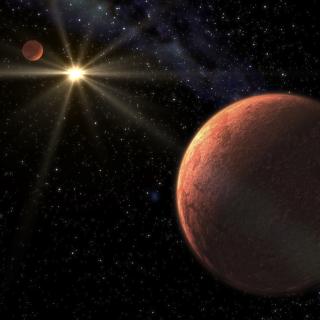Bibcode
Pavlenko, Y.; Suárez Mascareño, A.; Rebolo, R.; Lodieu, N.; Béjar, V. J. S.; González Hernández, J. I.
Bibliographical reference
Astronomy and Astrophysics, Volume 606, id.A49, 16 pp.
Advertised on:
10
2017
Journal
Citations
21
Refereed citations
21
Description
Context. We present the analysis of emission lines in high-resolution
optical spectra of the planet-host star Proxima Centauri (Proxima)
classified as a M5.5V. Aims: We carry out a detailed analysis of
the observed spectra to get a better understanding of the physical
conditions of the atmosphere of this star. Methods: We identify
the emission lines in a series of 147 high-resolution optical spectra of
the star at different levels of activity and compare them with the
synthetic spectra computed over a wide spectral range. Results:
Our synthetic spectra computed with the PHOENIX 2900/5.0/0.0 model
atmosphere fits the observed spectral energy distribution from optical
to near-infrared quite well. However, modelling strong atomic lines in
the blue spectrum (3900-4200 Å) requires implementing additional
opacity. We show that high-temperature layers in Proxima Centauri
consist of at least three emitting parts: a) a stellar chromosphere
where numerous emission lines form; we suggest that some emission cores
of strong absorption lines of metals form there; b) flare regions above
the chromosphere, where hydrogen Balmer lines up to high transition
levels (10-2) form; and c) a stellar wind component with Vr =
-30 km s-1 seen in some Balmer lines as blueshifted emission
lines. We believe that the observed He line at 4026 Å in emission
can be formed in that very hot region. Conclusions: We show that
the real structure of the atmosphere of Proxima is rather complicated.
The photosphere of the star is best fit by a normal M5 dwarf spectrum.
On the other hand, emission lines form in the chromosphere, flare
regions, and extended hot envelope.
The movies are available at http://www.aanda.org
Related projects

Very Low Mass Stars, Brown Dwarfs and Planets
Our goal is to study the processes that lead to the formation of low mass stars, brown dwarfs and planets and to characterize the physical properties of these objects in various evolutionary stages. Low mass stars and brown dwarfs are likely the most numerous type of objects in our Galaxy but due to their low intrinsic luminosity they are not so
Rafael
Rebolo López

Exoplanets and Astrobiology
The search for life in the universe has been driven by recent discoveries of planets around other stars (known as exoplanets), becoming one of the most active fields in modern astrophysics. The growing number of new exoplanets discovered in recent years and the recent advance on the study of their atmospheres are not only providing new valuable
Enric
Pallé Bago